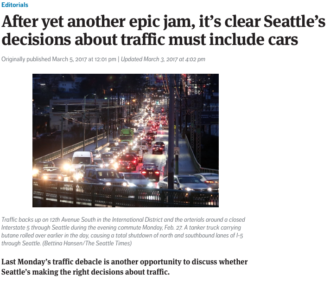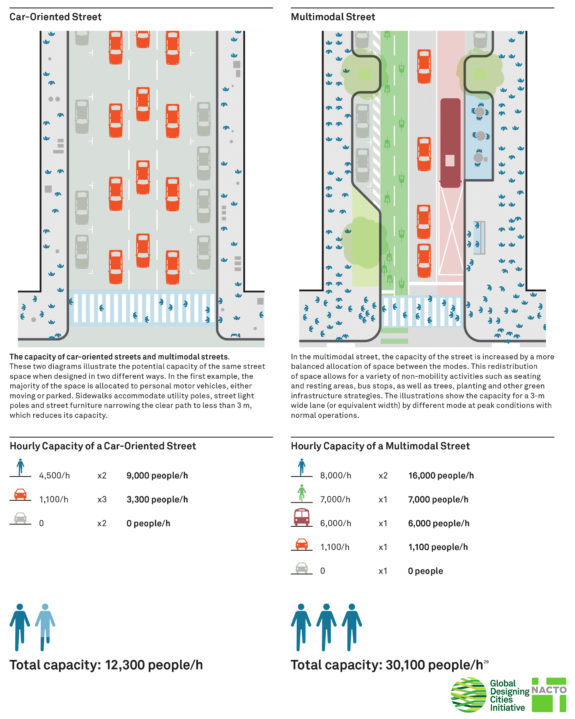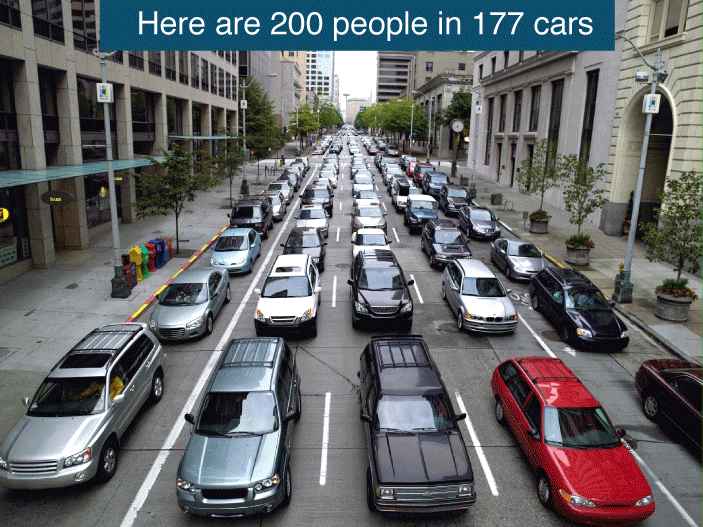
It seemed every couple minutes, someone at KUOW radio would break into the news broadcast to let people know of another major traffic problem in the Seattle area. It was February 27, and a truck carrying butane had crashed on southbound I-5 downtown.
The very hazardous payload forced brave emergency crews to close both directions of the major freeway at the interchange with I-90. During all this, snow and hail was coming down in various amounts in different parts of the region, further complicating people’s routes.
Traffic got so bad, a heroic taco truck called Tacos El Tajin that was stuck on I-5 simply opened its window and started serving other stranded travelers.
As traffic backed up, people trying to drive downtown blocked intersections and bus routes. People often use the term “gridlock” hyperbolically to describe bad traffic, but this was legitimately gridlock. Buses got more and more delayed by car traffic, reducing the effectiveness of the city’s most vital congestion relief valve. Link light rail saved the day for many people as one of the only services running reliably. Those who braved rare snowy streets to bike to work that day also found ways to get out of the city relatively easily by working through the snarled traffic. Most everyone else had a long journey home.
Listening to the traffic news get worse, I joked that I wondered how long it would take before someone blamed the horrendous traffic on bike lanes. One week later, the Seattle Times Editorial Board* delivered:
Major incidents will keep happening, and their effects are worsened because Seattle eliminated numerous arterial lanes in recent years. This reduced capacity hurt on Monday.
Lanes were replaced with bicycle paths. The problem isn’t adding bike paths, it’s that the city did so by reducing general traffic capacity. This makes the street network less resilient and capable of handling surges — and more dependent on I-5.
It’s hard to know where to start in responding to an editorial like this that is so wildly out of touch with reality in so many ways. At first I laughed. I-5 was closed in the middle of a work day and through the evening commute, but bike lanes are what caused the traffic? I mean, that’s legitimately funny.
But there are many people who were stuck in that traffic mess who are looking for someone to blame, and people biking are convenient scape goats. The region’s largest newspaper is using this obviously-unrelated traffic mess to argue against sorely needed bike safety projects. That’s less funny.
So, where to begin? First, what “bicycle paths” are they referring to? The city has built exactly one bike lane downtown in recent history that displaced a general traffic lane: 2nd Ave. That was in 2014. Seattle has lots of plans for more bike lanes, but the Times Board seems unaware that those plans have been delayed. Certainly plans for bike lanes didn’t cause the traffic jam, right?
But this raises a more important point: One more lane on 2nd Ave filled with stopped or crawling cars would have done nothing at all to help alleviate a total traffic system meltdown that happened last week. If anything, it would have made it worse.
Multimodal streets have more capacity than car-dominant streets. Here’s a graphic demonstrating this concept from the new Global Street Design Guide by the National Association of City Transportation Officials:
And for Seattle’s 2nd Ave, we just so happen to have a GIF demonstrating the same idea:
Of course, a bike lane on a downtown street is only going to fulfill its role in moving people efficiently if it connects to neighborhoods, jobs and destinations. Right now, 2nd Ave’s bike lane is alone in a sea of stressful downtown streets, which is why advocates are pushing for a Basic Bike Network downtown as part of the One Center City near-term work. 2nd Ave was billed as a pilot project, yet it is still all alone two and a half years later.
If the Times wants to be outraged about the city’s lack of action to address downtown congestion, they should be pushing the city to follow-through with its delayed downtown bike network. SDOT and Mayor Ed Murray are sitting on a planned and funded option for increasing capacity on downtown streets, and we can implement it very quickly if we make it a priority. So let’s do it.
The editorial also says that bike lanes make downtown streets “less resilient,” which is an interesting choice of words since “resilient” is one of the major adjectives Mayor Murray’s Move Seattle plan uses to support its calls for more biking, walking and transit priority:
A key to building a reliable transportation system is to build a system that is resilient — a system that has enough alternate routes and modes for people that it isn’t paralyzed by a construction project, a stadium event, a crash or a bridge opening.
The Seattle Times Editorial Board opposed the levy, which voters passed in 2015 by a strong margin. The people of Seattle agree with the Move Seattle principles and are ready to invest in its solutions. They understand that more people walking, biking and taking transit are the only real-life solutions we have to the problem.
Which brings us to the editorial’s most dangerous and radical point:
Because Seattle straddles state freeways at their busiest points, it should be ready to absorb the traffic when they’re disrupted.
Seattle is a city. Cities are places for people. Downtown Seattle is our biggest employment and destination center. It’s also a neighborhood where people live. Moving a freeway worth of cars is inherently antithetical to what makes Seattle’s downtown the desirable place it is.
There is no car-centric option for moving the growing number of people and goods around Seattle, and the Ed Board is delusional at best to say so (I dusted and found Brier Dudley’s fingerprints all over this one). American cities (including Seattle) have tried to follow the Ed Board’s windshield dream for the better part of a century, and we’ve found that it is impossible to remake city streets so they can carry more cars. Everything we do to meet demand creates even more demand:
We invest heavily in efforts to move more cars > streets become more dangerous and less comfortable > biking, walking and transit become less desirable > more people choose to drive > people stuck in traffic make calls for more car capacity > repeat until downtown is destroyed or the people yell “Stop!”
Across the nation, downtowns were hollowed out, business districts declined, neighborhoods were displaced and the traffic still got worse.
In the process, an unimaginable number of people were killed. Last year alone, more than 40,000 people died in American traffic collisions. Many times more were seriously injured, leaving them with lifelong injuries. The same amount of death and injury will continue until we do something to change it. The Ed Board’s take on downtown traffic is callous in ignoring the importance of protecting health and safety of our neighbors.
What’s so frustrating about this latest editorial is that the Ed Board is moving backward. In 2013, a year before the 2nd Ave bike lane opened, the Board penned an editorial supporting a network of safe bike lanes and neighborhood greenways, saying “Seattle should be in the vanguard” in building “a safe, comprehensive bike network.” They essentially called for the city build bike lanes like 2nd Ave. Now they are blaming the city for following through?
I get that there’s been changeover on the Board since 2013, but it’s pretty ridiculous to call for bike lanes, then turn around a few years later and say those same bike lanes are proof that the city is engaging in an imagined anti-car conspiracy.
Seattle must commit to its multimodal vision. I hope that by the time One Center City changes hit the ground, the Times Ed Board will have reconnected with the transportation needs of a 21st Century city.
* I want to be clear that there is a difference between the Times Editorial Board and the reporters doing very valuable and important work for the paper. I do not think frustrating editorials are a good reason to pull a subscription because we need a strong Seattle Times reporting staff. But the Ed Board ain’t doing reporters any favors by publishing absurd editorials like this under the same masthead.














Comments
21 responses to “After a butane truck crash on I-5 snarls traffic, the Times Ed Board blames … bike lanes?”
Great post!!!!
I just got this in an email too —
“For too long, America has been sold a myth that building urban highways will give us all more time, make developers flock to our real estate market, and magically, make us more more productive workers. Strong Towns wants that myth to end now.
In his conclusion to his ongoing series on economic impact studies (via the example of the proposed Shreveport 1-49 connector http://info.strongtowns.org/e/140101/shreveport/2prtxb/44375759 ), our president Chuck Marohn scrutinizes one of the most intangible “benefits” of highway projects—so-called “agglomeration effects” http://info.strongtowns.org/e/140101/s-of-the-i-49-connector-part-3/2prtxd/44375759 —and helps you understand what that word really means, and decode the 17 year old report about it that highway planners have been (mis)using to justify bad urban highway projects for years.”
It’s exactly these articles by the Editorial Board that leaves myself, and probably so many others, refusing to give one red cent to the Seattle Times.
I feel sad at the number of their employees losing jobs, but I would no more give money to a newspaper that publishes editorials like this, than I would support a quality local newspaper that occasionally publishes neo-nazi apologetic pieces, either.
So sad in this era when progressive people like the readers of this blog are committing money to support quality journalism that the ST can’t reap the rewards because of their conservative political agenda.
Of course, nobody’s obligated to subscribe to any newspaper for any reason.
But this just went from 0 to Nazis in ten seconds.
There are other, better ways to talk about people we disagree with!
I very nearly cancelled my subscription to the Seattle Times after reading this idiotic editorial. Consider cars? WTF do they think the city has been doing for the last hundred years? The SOV is even more obsolete than the Seattle Times and the majority of their readership (judging by the comments section). What a pack of dinosaurs. Their answer to the problem of too many cars cramming into too little geography is “more of the same?” Too bad for you, if you refuse to abandon your car and choose a less expensive, faster, less polluting alternative. You deserve to be stuck in traffic!
That crash was on 27 February. The West Seattle Water Taxi also saved many people from being trapped downtown for the duration:
http://westseattleblog.com/2017/02/followup-west-seattle-water-taxi-more-than-tripled-ridership-during-tanker-truck-trouble-traffic/
The Times had a booth at the Seattle Bike Show
Keep your friends close and your enemies closer.
You expect sanity from the Seattle Times?
Great post.
However, reading the endless anti-bike comments on the editorial I think they completely identified with their target audience.
Remember we live in a post-truth, post-fact world so blaming everything on bike lanes makes perfect sense.
My commute home was horrible that day! An Uber driver blocking the bike lane caused me to miss a light, and it took me 26 minutes instead of my normal 25 minutes. Following the Times wacky logic, I cursed Tim Eyman for that Uber driver.
You should be angry! Ban Uber!
Good one ;)
[…] Fucoloro at Seattle Bike Blog posted this […]
Nothing brings out the inner toddler like getting behind the wheel. “But it’s not fair!! If I have to be stuck in traffic so should that person on a bike over there!”
Now we’ve got politicians on both sides of the aisle tripping over themselves to introduce ’emergency’ legislation about ‘skyrocketing’ car tabs. Yes, that will help congestion. It takes a real idiot to think that reducing the cost of driving will help traffic.
Wouldn’t it be nice if ST would help to dispel these myths instead of perpetuating them?
The only people who made it anywhere in a reasonable time that day biked or took LINK (or a combo of the two).
My ferry commute was as awesome as always.
[…] scapegoating them, but in actuality they rarely reduce throughput for cars. As Seattle Bike Blog pointed out, the only protected bike lane to replace a general purpose lane was Second Avenue, which was […]
I was astounded that the Seattle Times appeared to have passed over the control of its editorial to the degenerates who dominate its comments. However, their idea of increasing traffic lanes in an emergency has some merit. Rather than complaining about the whopping 3 segments of protected bike lanes in downtown, perhaps they could have focused on the countless lanes of parking. If the emergency had led to a suspension of street parking downtown, then within 2 hours, the capacity of downtown traffic lanes could have been increased ~50% which coupled with adequate police control at intersections (another idea in the editorial and a must to stop drivers clogging intersections) and some emergency rerouting of buses, could have routed traffic and public transits efficiently around the blockage.
In addition to parking (See William’s comment) I find it odd that the Seattle Times didn’t question whether lanes closed for construction of nearby buildings really need to be closed at all times. 2nd Ave north of Stewart Pike & Pine is a great example. One project has had a trailer with large steel beams / supports parked in what used to be the bus lane for several days now with no sign that any of those beams are being used. Perhaps the city should require “Just In Time” delivery unless there is a very good reason to have those beams taking up public ROW 24/7.
Great post. The gif says it all. I don’t know why this is so hard for people to understand. Cars don’t work when population density reaches s certain point because there isn’t enough space. It’s not a political or planning problem, it’s just physics. If you are married to your car, move to the suburbs. As bad as the Seattle times editorial board is- I think the paper is otherwise pretty good, and I am inclined to continue subscribing, especially with our fake Pres. waging war on legit media sources.
Great post! Is anyone (Cascade or Seattle Bike Blog) meeting with the Times board to educate them on these issues? It would be so much better if they supported bicycle commuting and other issues.
[…] MP who even the Daily Mail refers to as a petrolhead? This is a widespread problem, as bike lanes cause gridlock in Seattle that had absolutely nothing to do with a truck full of butane crashing on the Interstate. At all. […]